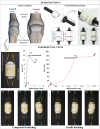Bimodal buckling governs human fingers' luxation
- PMID: 37871221
- PMCID: PMC10622902
- DOI: 10.1073/pnas.2311637120
Bimodal buckling governs human fingers' luxation
Abstract
Equilibrium bifurcation in natural systems can sometimes be explained as a route to stress shielding for preventing failure. Although compressive buckling has been known for a long time, its less-intuitive tensile counterpart was only recently discovered and yet never identified in living structures or organisms. Through the analysis of an unprecedented all-in-one paradigm of elastic instability, it is theoretically and experimentally shown that coexistence of two curvatures in human finger joints is the result of an optimal design by nature that exploits both compressive and tensile buckling for inducing luxation in case of traumas, so realizing a unique mechanism for protecting tissues and preventing more severe damage under extreme loads. Our findings might pave the way to conceive complex architectured and bio-inspired materials, as well as next generation artificial joint prostheses and robotic arms for bio-engineering and healthcare applications.
Keywords: dislocation; elastic stability; finger joint; tensile buckling.
Conflict of interest statement
The authors declare no competing interest.
Figures




References
-
- Gray H., Anatomy of the Human Body (Philadelphia Lea and Febiger, ed. 20, 1918).
-
- Brocato M., Podio-Guidugli P., A bone-wise approach for modeling the human hind-midfoot. Part i: Kinematics. Meccanica 57, 977–998 (2022).
-
- Gray J., How Animals Move (Cambridge University Press, 1953).
-
- Mow V. C., Ateshian G. A., Spilker R. L., Biomechanics of diarthrodial joints: A review of twenty years of progress. J. Biomech. Eng. 115, 460–467 (1993). - PubMed
Publication types
MeSH terms
Grants and funding
LinkOut - more resources
Full Text Sources

